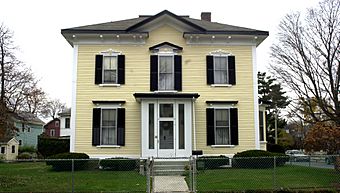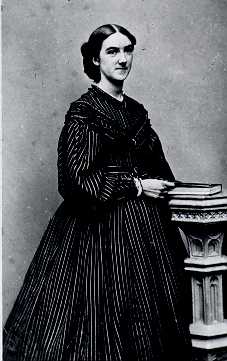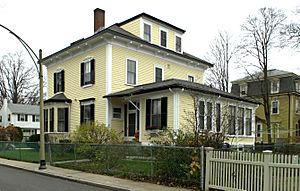Ellen Swallow Richards House facts for kids
|
Ellen Swallow Richards Residence
|
|
|
U.S. Historic district
Contributing property |
|

Main facade
|
|
| Location | 32 Eliot St., Jamaica Plain, Massachusetts |
|---|---|
| Area | 0.2 acres (0.081 ha) |
| Architectural style | Italianate |
| Part of | Monument Square Historic District (ID90001536) |
| NRHP reference No. | 92001874 |
Quick facts for kids Significant dates |
|
| Added to NRHP | March 31, 1992 |
| Designated CP | October 11, 1990 |
The Ellen H. Swallow Richards House is a special historic home in Jamaica Plain, a neighborhood in Boston, Massachusetts. It was the home of Ellen Swallow Richards from 1876 until she passed away.
Ellen Richards was a truly amazing person. She was the very first woman to graduate from the Massachusetts Institute of Technology (MIT). She also became MIT's first female teacher!
Ellen Richards had groundbreaking ideas about keeping homes clean and healthy. She did important work, some of it right in this house. Her research helped create the field we now call home economics.
Her house was often changed because of her experiments. She even used it as a lab to test everyday products. Because of her many achievements, this house was named a National Historic Landmark in 1992.
Contents
About the House
The Richards house looks like a typical two-story Italianate style home from the outside. It sits on a good-sized lot at the corner of Eliot and Dane Streets. The house has a low, sloped roof and decorative trim.
A Home That Was Also a Lab
The inside of the house, especially the kitchen, was changed a lot by Ellen and her husband, Robert. They moved in during 1876. The biggest changes were to the plumbing and how air moved through the house.
The house got its water from a well. Ellen made sure that dirty water from the house would not flow back towards the well. She regularly updated the pipes. She added special "traps" to stop clean and dirty water from mixing. They even replaced lead pipes because they knew lead could be dangerous.
Breathing Easier: Air Quality Experiments
Before electricity, the house used gas for lights and coal for heat. These could create unhealthy fumes. Ellen Richards made changes to improve the air inside.
She replaced windows with ones that could open from both the top and bottom. This allowed warm, polluted air to escape from the top. She also cut holes in walls and ceilings above lights and heaters. This helped fumes leave the house.
A main vent was put in the attic, and a mechanical fan system was added. A range hood was installed over the kitchen stove. As soon as electricity came to the neighborhood, the Richardses had their house wired. This removed many sources of fumes. They were also among the first in the area to get a telephone!

Testing Products and Creating a New Field
Ellen Richards used her own home life to do experiments and make things more efficient. For example, the gas meter was placed in the kitchen. This way, she could see how much gas was used with different cooking methods.
She tested all sorts of home gadgets. She or her students, who sometimes lived with the family, would test how well these gadgets worked. These experiments, along with her work at MIT, led to the field of home economics. This field teaches how to manage a home and family well.
Her other work at MIT helped improve things like cleaning wastewater. She also found better ways to ventilate factories to prevent fires.
A Special Landmark
The Richards house was recognized as a National Historic Landmark in 1992. It was also added to the National Register of Historic Places. This honor celebrates Ellen Swallow Richards' many important achievements. The house is also part of the larger Monument Square Historic District.




